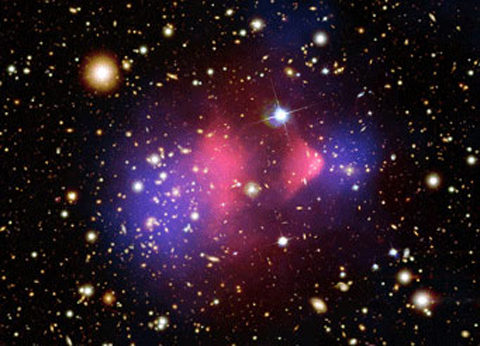Sky and Telescope quotes Dr. Douglas Clowe, Associate Professor of Physics & Astronomy, in an article on “How Slippery is Dark Matter?”
“Dozens of galaxy cluster collisions confirm that dark matter particles probably slip right past each other within messy cluster mergers,” writes Monica Young. “The existence of dark matter would solve many problems in our universe: it enables spiral galaxies to rotate quickly at their outer edges, keeps galaxy clusters from flying apart, and forms the universe’s cosmic web structure.
Young’s article focused on a challenge to previous models of from dark matter. “Simulations show that dark matter pools in gravitational wells, creating galaxies and clusters of galaxies with far denser cores than observed. That pooling happens when dark matter particles are slippery,” writes Young. “One way to overcome the pooling problem is to make dark matter less slippery….But now these sticky dark matter models face a challenge. David Harvey (Observatoire de Sauverny, Switzerland, and University of Edingburgh, UK) and colleagues studied 30 galaxy clusters and found that dark matter particles appear to be quite slippery, with a cross section no higher than 0.47 cm2/g.”
A New Look at the Bullet Cluster

The Bullet Cluster is the textbook example of merging galaxy clusters. Hot gas (pink) sloshes around the galaxies (red, green, blue) that are anchored in dark matter (blue).
X-ray: NASA / CXC / CfA / M.Markevitch et al.; Lensing Map: NASA / STScI / ESO WFI / Magellan / U.Arizona / D.Clowe et al.; Optical: NASA / STScI / Magellan / U.Arizona / D.Clowe et al.
Young explains that Harvey’s group took a statistical approach to the “Bullet Cluster,” using Hubble Space Telescope archives and “averaging out the measurements of lots of galaxy clusters to do away with any 3D uncertainty.”
“There are limitations to this approach, says Douglas Clowe (Ohio University). For one, it’s all archival data, collected for disparate science goals. So Hubble imaged some clusters through multiple filters and some through only a single filter. To level the playing field, the team opted to limit their analysis to a single filter for all the clusters. But that makes it difficult to separate cluster galaxies from foreground and background galaxies. While necessary, the decision added uncertainty to their measurements.
“Nevertheless, Clowe adds, ‘Within the limitations of their data, they have produced an excellent analysis.’ In addition to improving on the Bullet Cluster measurements, he says, these types of statistical studies, which pull in huge amounts of information on dozens of galaxy clusters, show what we can look forward to in five to ten years, when next-gen telescopes such as WFIRST, LSST, and Euclid come online.”



















Comments